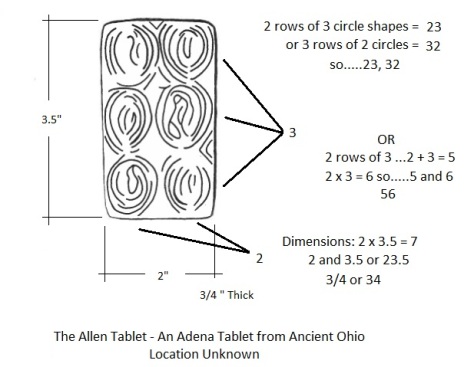© 2014 B. L. Freeborn
There are about a dozen small stones decorated with art that are called the Adena Tablets. They were found in various places throughout Ohio and in neighboring states. Sometimes they were found lying on the surface of the ground, but most often they were associated with mound sites. There are several persons who have published translations such as David W. Penny in the Mid-Continental Journal of Archaeology in 1980, J. Ralston Skinner in the Cincinnati Society of Natural History in 1885, (Note the time span.) and Duncan Caldwell in 1997 in Ohio Archaeologist.
A new way of reading them will be suggested here. So, we begin with the easiest only because it is so obscured by time there is virtually nothing left and ultimately we will be reading such beautiful art as the Ohio Adena Pipe, now a Ohio State symbol, and the Hopewell Shaman – Bear. Check out the links at Ohio History to see these items.
The first reading is of the Allen Tablet as shown in the sketch. (No better image was found.) It is unclear if David Penny drew this or if he took it from Ellis H. Holmes’ 1944 article. Either way, all that can be seen is six circular blurbs. The original is long missing so there is no way to verify its design further. Penny reports it is made of sandstone. It is only 2″ wide and 3 ½” tall so it easily fit within the palm of a hand. These were often covered with red ocher and some suggest they were used in printing or laying on designs. Based on reading Lena Lenape Indian traditions, it is possible the red ocher was used to make them more beautiful and to make the designs leap out.
So, …. how is it this stone just happened to be 2″ by 3 ½” ? Of all the random sizes available how did the artist just happen to use measurements that fall so close to standard English inch sizes? We shall examine this topic closer in the future. Also note it was 3/4 of an inch thick and then observe the numbers as noted in the diagram that can be made from these dimensions: 7, 34 and 23.5.
From the art itself other numbers can be created just by counting the circular blurbs. Find: 23 32, and 56. The most obvious should be noted: three circles and three circles creates 33.
These are seemingly six random meaningless numbers, yet we see 34 + 56 = 90 and there are 90 degrees from the equator to the pole and 90 degrees in each quadrant of direction North to East, East to South, etc. Degrees are composed each of 60 minutes and 23.5 degrees can be written as 23 degrees 30 minutes which looks remarkably like the 23 32 obtained from counting blurbs. The Arctic Circle is defined by this latitude.
Seven we realize is the number of days in a week but there is no way these people also had seven day weeks or perhaps they did. Either way, seven is of great importance throughout a vast number of old world religions.
But we saw this 23 32 before in the Newark Earthworks. And we saw it in the Scottish Pict’s Aberlemno Stone. We also saw 56 in both of those and we found 34 there as well. Could this art lend credence to that strange tale related about the validity of the Newark Decalogue Stone?
Perhaps…. this is more Baalist artwork. But what does it all mean?
The mystery unravels further one stepping stone at a time.
Index to posts on Adena Stones and beginning post:
Next post on Grave Creek Tablet, and pdf article on
Hudson Bay as a comet crater of recent origin.
